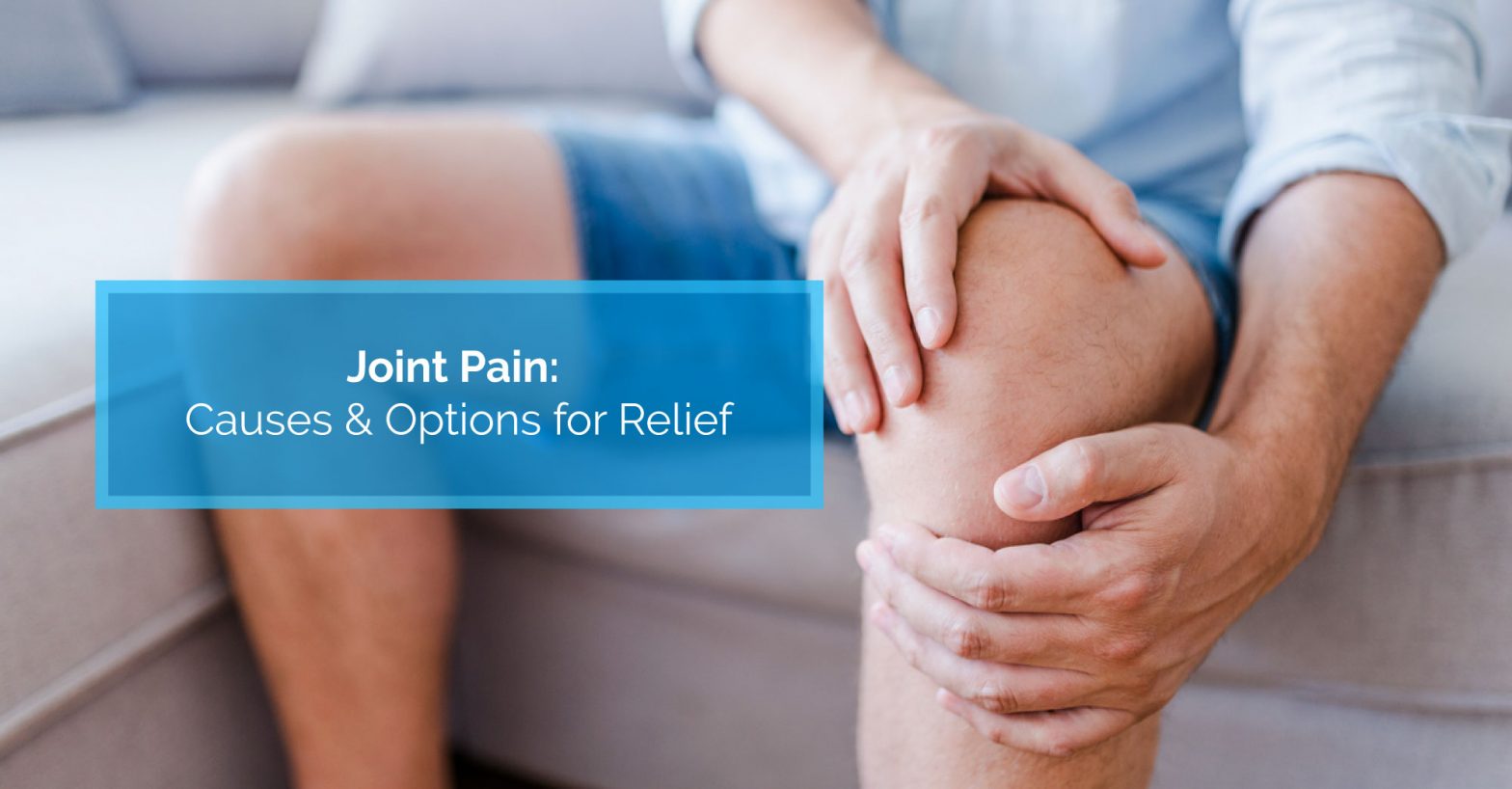Osteoarthritis Treatments: What You Need to Know...
Key Highlights: Osteoarthritis treatments focus on pain relief, restoring joint…
Read More
Posted by Dr. Scott Wilson | 15-Jul-2022
Joint pain in the hands, feet, hips, knees, or spine, is a common condition and increasingly more prevalent as we age. While some may experience constant or chronic joint pain, others experience pain that comes and goes based on their activities. The pain itself varies but most often it’s a burning, throbbing, or “grating” sensation. Joint pain has a wide range of causes including:
Osteoarthritis, the most common type of arthritis, causes the space between our bones to narrow as the cartilages and flexible tissue lining the joints deteriorates. Over time, it results in changes to the shape of the bone surfaces, joint degradation, and extreme pain. Osteoarthritis usually causes joint pain flare ups and a crackling or grating sensation after you engage in activities that put stress on your joints.
Rheumatoid arthritis is an autoimmune and inflammatory disease. It causes the immune system to attack healthy cells by mistake, and specifically affects the lining of the joints. This causes inflammation and damage to the joint tissue resulting in painful swelling and significant discomfort. Rheumatoid arthritis often leads to long-lasting chronic joint pain and may result in a lack of balance, especially among elderly people.
Bursitis is an irritation or inflammation of the bursa sac. Bursa sacs are present all over our body and contain fluids that lubricate the rubbing and friction between bones, muscles, tendons, and skin. Bursitis is often the result of overuse or continuous pressure on a specific area. Improper posture while sitting and standing, not stretching adequately before exercise or injuries to the joints can lead to bursitis.
Gout is a type of inflammatory arthritis that causes sudden and intense joint pain. It is mainly caused by health conditions, like diabetes, high blood pressure, excessive weight, or psoriasis. The pain is usually felt in the big toe and at night, however, it also often causes severe joint pain in other toes, the ankles, and the knees. Gout is often experienced by those with high levels of uric acid caused by the breakdown of purines commonly found in our cells. Although red meat, organ meats, and some seafood can also increase uric acid.
Tendinitis is the term given to the inflammation or irritation of the tendons, thick fibrous cords that are extremely flexible and attach muscle to bone. This condition mostly affects the shoulder, bicep, elbow, hand, wrist, thumb, calf, knee, or ankle. Tendinitis often occurs near a joint, is therefore mistaken for arthritis, and mostly affects athletes and adults over the age of 40.
Post-traumatic arthritis or joint pain is caused by injuries, bone fractures, or dislocations. Although not chronic, it can take months to heal. If injuries or unbearable sprains are not effectively treated, they can lead to faster wear and tear, and eventually result in other forms of arthritis. Unlike the usual forms of joint pain or arthritis, post-traumatic joint pain is more commonly found in younger people – including kids and teens.
Poor dietary and nutritional choices can cause and increase joint pain. Excessive amounts of rich, fatty, sugary, or starchy foods can increase weight, especially for people leading a sedentary lifestyle. This extra weight can result in stress on the joints, accelerated degeneration and increased joint pain.
While no single food can improve joint health and relieve pain, a well-balanced diet and proper exercise are key to keeping joints flexible and maintaining joint health. Here are a few foods that you can include in your diet to help improve your joint health:
Avocados are one of the best foods for helping to relieve joint pain. These fruits contain monounsaturated fatty acids which help reduce inflammation and increase blood flow to your joints.
Olive oil contains antioxidants which help fight free radicals and inflammation. It also helps reduce swelling and inflammation caused by arthritis or other forms of joint pain.
Bananas are high in potassium and magnesium, which is essential for muscle relaxation and joint health. They also contain anti-inflammatory properties that help reduce pain and swelling in the joints.
Salmon is high in omega-3 fatty acids, which can help repair damaged cartilage and bone. It’s also high in protein and contains vitamin D, which helps build healthy bones.
Walnuts are packed with antioxidants and vitamins, including vitamin E, and zinc. They also contain magnesium, which is an essential nutrient for healthy joints.
Ginger has been shown to be effective against joint pain due to its anti-inflammatory action. It helps in reducing the activity of several chemical substances that promote joint inflammation.
Today, there are a variety of treatment options available for joint pain. Of course, the suitability of a particular option depends on the specific nature of your condition. Here are some of the most common treatment options available for joint pain:
Medications and ointments are often used for moderate-to-severe joint pain due to inflammation. Aspirin, celecoxib, ibuprofen, or naproxen for are also prescribed relief. The specific medication depends on the underlying cause of the condition. Muscle relaxants and topical agents such as capsaicin or arthritis ointments that contain methyl salicylate are also often recommended.
Injections are sometimes considered when medications or ointments are unsuccessful. Removing fluid from the joint and replacing it with a synthetic version of the natural joint fluid such as hyaluronan is also an option. Other injection-based joint pain treatment options include steroid medication, platelet-rich plasma therapy, and prolotherapy.
Physiotherapy, or physical therapy, is the most commonly suggested non-invasive treatment option for joint pain. Not only does it help to provide relief, it also strengthens the surrounding muscles which helps stabilize the joint, improve balance and range of motion, and prevent the pain from recurring. Physiotherapists will create a custom treatment plan based on your condition that may include therapies such as ultrasound, heat or cold therapy, exercises, electrical nerve stimulation, massage, and joint manipulation.
While pain relievers may offer quick relief, the right set of exercises can be an effective way to tame ankle, knee, hip, or shoulder pain. Regular exercises can provide relief and help improve the joints as well. It can also be a great way to keep you physically fit and overcome physical limitations. Exercise routines can include low-impact aerobic exercises, gentle stretching, and strengthening exercises that can strengthen the core muscles.
Physiotherapy and regular exercise are some of the best options for preventing and relieving joint pain. However, if your joints are past the point of remediation, surgery may be a last resort. There are different types of surgeries available including arthroscopy, total joint replacement, osteotomy, and joint fusion. The specific surgery chosen depends on the nature of the condition. Physiotherapy is also an important part of post-surgery rehabilitation to restore range of motion, flexibility and overall strength.
Taking steps as soon as possible to address joint pain can reduce the damage it does to your bones and muscles and can help to overcome and prevent conditions that limit your body’s ability to move and function. Effective physiotherapy treatment, in particular, not only helps to relieve pain, it also plays a pivotal role in joint pain prevention.
If you need help addressing your acute or chronic joint pain, contact us today and let us show you why, at Physiomed, Healthier Starts Here.

Key Highlights: Osteoarthritis treatments focus on pain relief, restoring joint…
Read More
Key Highlights: Runner's knee, or patellofemoral pain syndrome, is a…
Read More
Key Highlights: Upper back and neck pain can be caused…
Read More
Key Highlights: Many people want to lose belly fat for…
Read More
Key Highlights: Vestibular physical therapy, or physiotherapy, is a specialized…
Read More
Key Highlights: Tennis elbow, or lateral epicondylitis, is a condition…
Read More